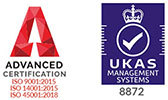Counterbalance forklifts are just one type of forklift on the market, coming alongside VNA and multi-directional forklifts. It can be overwhelming to choose a forklift for your warehouse, especially if you don’t know all of the options that are available to you. In this article, we’ll be guiding you through everything you need to know about counterbalance forklifts.
C
What is a counterbalance forklift?
A counterbalance forklift is a forklift that can be operated in a variety of settings, from vast areas to tight spaces. Despite their compact, neat design, they come equipped with rear counterbalance weights to enable it to lift even the heaviest of loads. They come in a wide range of fuel types and they also have different weight and lift capacities to choose from. Let’s delve a little deeper into counterbalance forklifts.
C
Counterbalance forklifts & their fuel types
Counterbalance forklifts, like other forklift models, come in a wide range of different fuel types, including electric, LPG and diesel. Electric and LPG forklifts are ideal for warehouse owners who are looking to reduce their carbon footprint.
However, diesel counterbalance forklifts can be used outdoors on rough, loose or uneven terrain and for particularly heavy applications. In addition, electric forklifts can be used inside as they’re very quiet and they also give off zero emissions.
No matter how your counterbalance forklift is powered or fuelled, it will make short work of any warehouse task you have outstanding. You’ll be sure to find a counterbalance forklift that suits your every material handling need when you choose Multy Lift.
C
What is a counterbalance forklift used for?
A counterbalance forklift is used for a number of different tasks and applications. This makes them ideal for use in several industries. Essentially, a counterbalance forklift can be used for a number of different things, because they’re so efficient in the following challenges involved when it comes to handling heavy loads:
- Stacking
- Lifting
- Loading
- Unloading
- Transporting
- Shifting
C
How does a counterbalance forklift work?
A counterbalance forklift works impressively, with the ability to turn in tight areas and navigate small spaces completely effortlessly. But how does such a powerful machine have the ability to work in such a way? Let us explain to you have a counterbalance forklift works:
The lifting mechanism
A counterbalance forklift hinges on a hydraulic system. The operator channels hydraulic fluid into the forklift’s cylinders, using levers. This fluid then pushes past the pistons, therefore causing the mast and forks to elevate. To avoid the forklift from tipping over, the rear counterweight maintains the forklift’s equilibrium, therefore ensuring safe lifting without the chance of the forklift tipping under the weight it’s carrying.
The counterbalance weights
The counterbalance weights on a counterbalance forklift are located at the rear of the forklift. They stabilise the lifting machinery for ultimate safety, essentially counterbalancing the load’s weight. This enables counterbalance forklifts to manage loads with additional support, to stop the forklift from tipping under the weight it is carrying.
The safety features included on a counterbalance forklift
By using rear counterweights, it ensures stability. But it also comes equipped with emergency brakes should the forklift need to brake suddenly. Depending on the model you choose, some vehicles come with overload alarms, notifying the operator that the load being carried is too heavy for the machine to handle.
There are also alarms that sound when the forklift is reversing. In addition, anti-slip platforms and mast tilt functions are available to enhance operational safety. Not only does this safeguard the operators, but those who are nearby also.
C
What are the benefits of counterbalance forklifts?
You’ll have nothing to lose and everything to gain by implementing counterbalance forklifts in your warehouse. Although, they can be used in a wealth of sectors and industries. From retail and hospitality right through to construction and engineering, a counterbalance forklift can do it all.
Counterbalance forklift benefits
- They’re versatile machines – counterbalance forklifts can be used in a wide range of settings and industries. They can be counted upon to carry out various tasks, no matter how heavy-duty they are
- They’re easy to operate – with the right training, the forklift operator will be able to use a counterbalance forklift with complete ease
- They’re efficient is space utilisation – counterbalance forklifts are able to navigate compact areas with ease, making them efficient for use in a variety of settings
- They have larger loading, lifting and height capacities – counterbalance forklifts have an impressive lift and height capacity. This therefore means that they can be used to carry out the most heavy duty tasks, as and when needed
- They come in a range of fuel types – counterbalance forklifts come in a range of fuel types, including electric, LPG and diesel
- They can be used both inside and outdoors – counterbalance forklifts can be used both indoors and outside
C
C
Multy Lift has over three decades of experience in the material handling industry. We take pride in providing customers throughout the UK with the ultimate warehouse solution. From forklifts and order pickers to reach trucks and industrial cleaning machines, there’s nothing we can’t do when it comes to material handling equipment and expertise. If you would like further information about how we can help you today, get in touch with a member of our friendly, professional team – we’re always pleased to hear from you.







